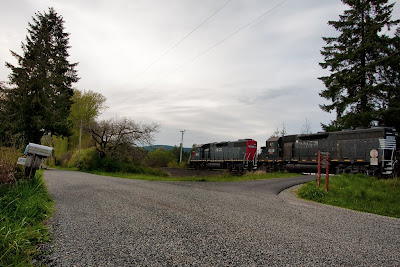I ventured down to the Gorge a week prior to the rest of the clan dropping in to do some site scouting. In the past I have car-camped at the west siding switch at Maryhill but noticed this year new "no trespassing" signs posted which was unfortunate because the previous trip sans signs resulted in a some dramatic results

Well faced with the prospect of finding another location this year, I camped out at Avery which is located west of Wishram. This is a great place, but the downfall is the traffic on the gravel road and the proximity to the grade crossing. Thanks to the grain traffic a higher than normal traffic pattern set up most of the night, they were "running like streetcars".....
A full moon and a high cloud deck greeted me the first night where I set up over Wishram of a shot of the River and the Oregon side of the river, I-84 and a northbound BNSF train off of the Oregon Trunk line snaking into and out of the tunnel below Moody.

The grade crossing at the east switch at Maryhill is also a great place to work photos of the signals and passing trains. A dispatchers favorite, the Maryhill siding is in constant use and this night was no different. A grain empty is holding the main while the dispatcher has a grain empty already lined out the east end of the siding.

Many local photographers know that the a strange thing sometimes happens when you go east in the Gorge - the sun most of the time shines bright. This trip was no exception with rain and clouds socking in the west side of the Cascades, it was a nice and bright morning in the Gorge as an eastbound V-PTLBLU glints along near Lyle, WA

A nearly on time Amtrak Empire Builder hustles across a fill almost to its station stop at Bingen, WA. This is the Portland section of the Builder and has coaches, sleepers and the observation lounge. The Seattle section at the same time is crossing Stevens Pass with a slightly larger train after having split in Spokane.

Night can be a magical time in the Gorge - especially when you can work in the local "color". The Dalles, OR is a town that is steeped in railroad and industrial history. Here a westbound stack train skirts through town in the pre-dawn hours with the Sunshine Mill standing tall in the background. Built in 1911 after the previous mill burned, the Mill was at one point served by the Union Pacific and the Great Southern Railway. It is now home to a local winery.

A cloudy morning has yet wielded to the sun, but the traffic still moves and the grain is in full rush. Framed by the bridge at The Dalles, a westbound load is making trackspeed heading for Tacoma, WA and the export terminal.

The following week a group of us descended on the Gorge again with us setting up at Camp Avery. Busy traffic kept us awake for most of the night with BNSF sending 12 trains by in just over 6 hours. We had decided that we would spend out time between Maryhill and Celilo since the traffic was forecast to be pretty constant. Here an EB empty is trying to make it as far east as it can before encountering a fleet of 7 westbounds. The gravel road to the left is the original SP&S grade prior to the building of the John Day Dam.

The line relocation required some extensive cuts and fills along the line. This long cut is located just west of Maryhill and a 4wd vehicle makes for quick access to the top of the cut. Maryhill is a favorite area of our friend Dan Schwanz for which we nicknamed this spot Schwannies Cut.



The locations on the Oregon side are as dramatic as on the Washington side but can be even more so with the addition of the Oregon Trunk line into the center of Oregon and into California.



A big thanks to those that made it out to this trip to the Gorge including Dale Skyllingstad, Joel Hawthorn, Drew Mitchem, Ted Curphey and Paul Petersen.






































